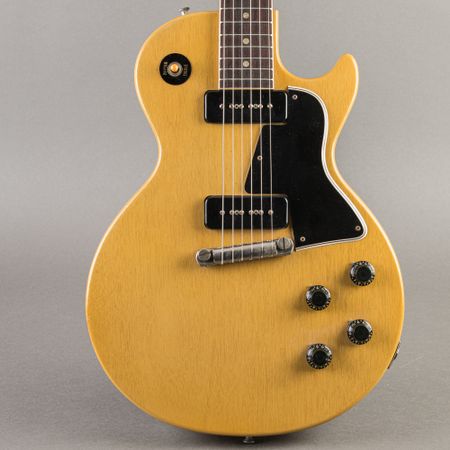
The “Standard”: History of the Les Paul Burst
Hello, my name’s Gary Bohannon. I work at Carter Vintage Guitars here in Nashville. I’m an authenticator and an appraiser. My job is to look at old guitars all day long. And today we have maybe one of the coolest old guitars, certainly one of the most collectible old guitars in the history of electric guitar production. The Gibson Les Paul Standard. This particular model is from 1960.
The Les Paul was introduced in 1952. It was Gibson’s answer to the Fender. First, the Esquire, then it was called The Broadcaster, then it was The Nocaster, and then it became the famous Telecaster. It was the first production solid body guitar. And Gibson wanted to get in on the fun. So they came up with a guitar design with Les Paul.
They called the guitar the Les Paul Standard.
It had a gold top, natural back and sides, and a trapeze tailpiece, which wasn’t really popular. So that changed after the first year or so to a stop tailpiece, which was a better design as far as players were concerned. But it wasn’t really good for intonation. The guitar would go out of tune as you go up the neck.
The next thing they did to sort of correct that problem, they introduced a bridge, the ABR-1 bridge, and it was an adjustable bridge. It had saddles that moved back and forth. So as you play up the neck, you could move the saddles around and tune the guitar. That was a huge invention for Gibson. The next thing that happened with the Les Paul was the pickups were addressed.

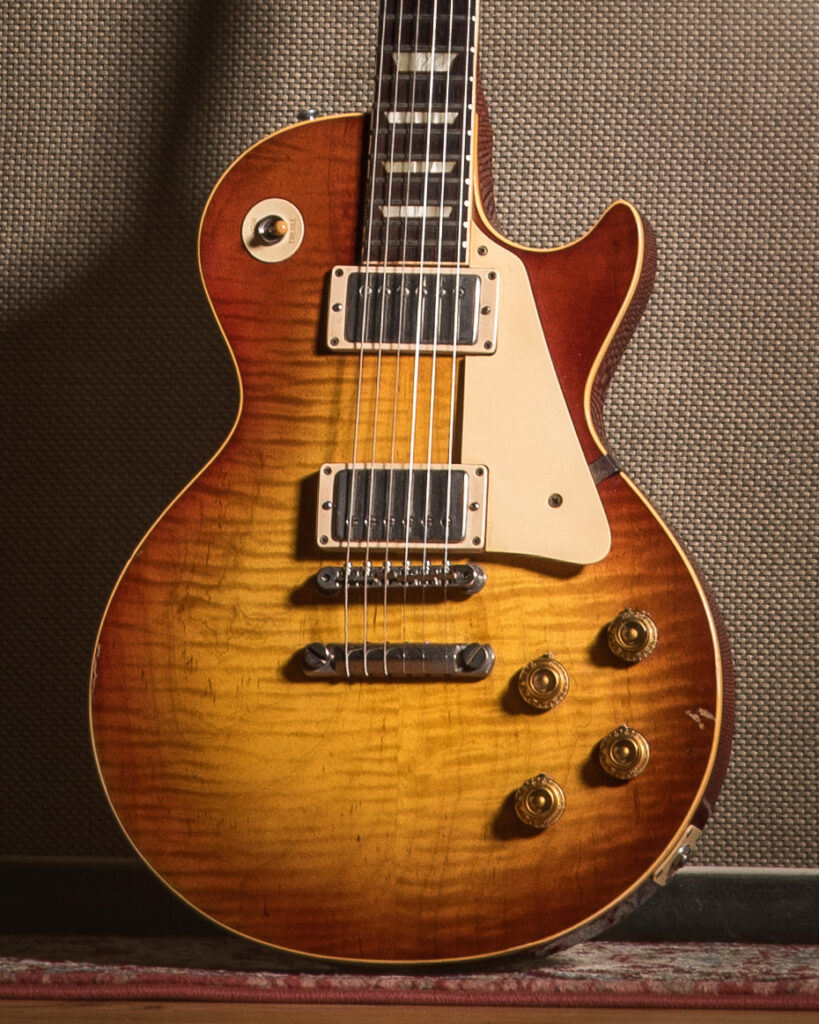
The first Gibson’s had P-90 pickups, which are single coil pickups, and they hum a lot.
Gretsch was having the same problem with their guitars, and it’s interesting that both companies addressed the problem almost the same way, simultaneously. Gibson worked with Les Paul worked with a man named Seth Lover, and in 1956 and 1957, they developed a humbucking pickup, two coils and one coil would cancel the other coil. And without getting real technical, you’d have a pickup that wouldn’t hum. You could play the guitar in an environment with fluorescent lights and not have to worry about having a massive amount of hum coming through your amplifier.
The next thing that Gibson did, now these guitars – Les Pauls weren’t super popular. They didn’t do real well. They, a lot of ’em ended up in pawn shops, I think Freddie King’s. The story I heard, Freddie King was one of the first Les Paul operators, and I think he got his guitar in a pawn shop by the late ‘50s. You know, Gibson was trying different things to make the guitar more popular, so they decided to change the finish.
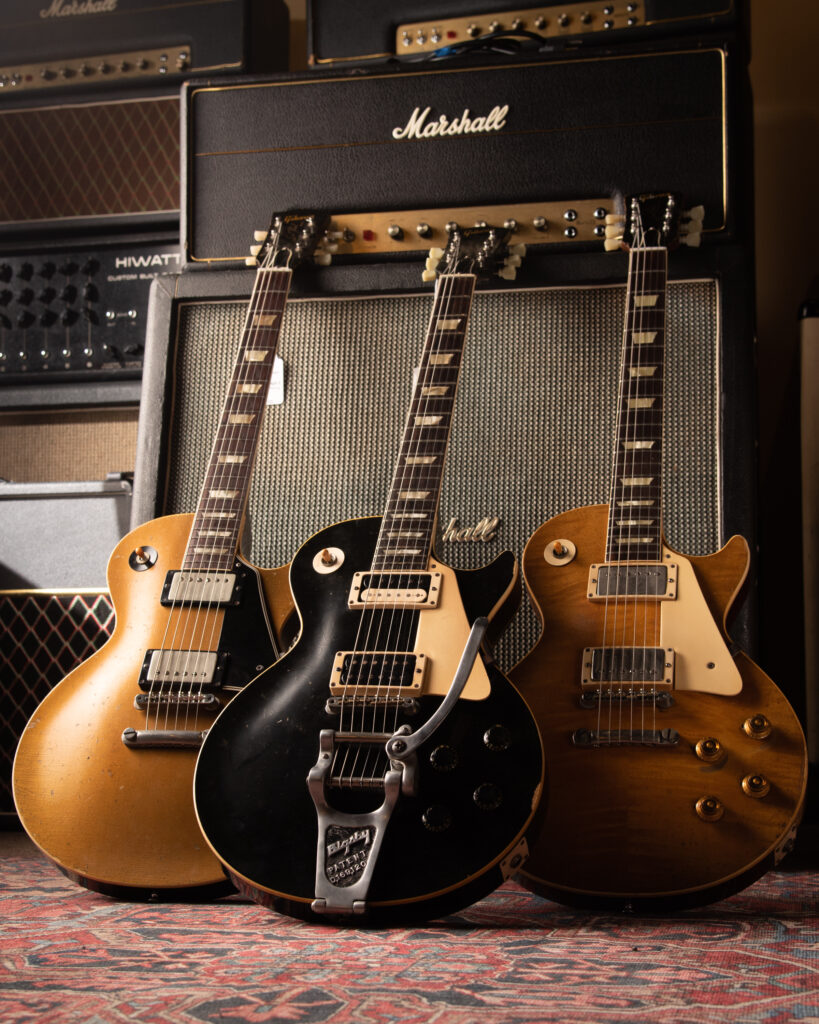
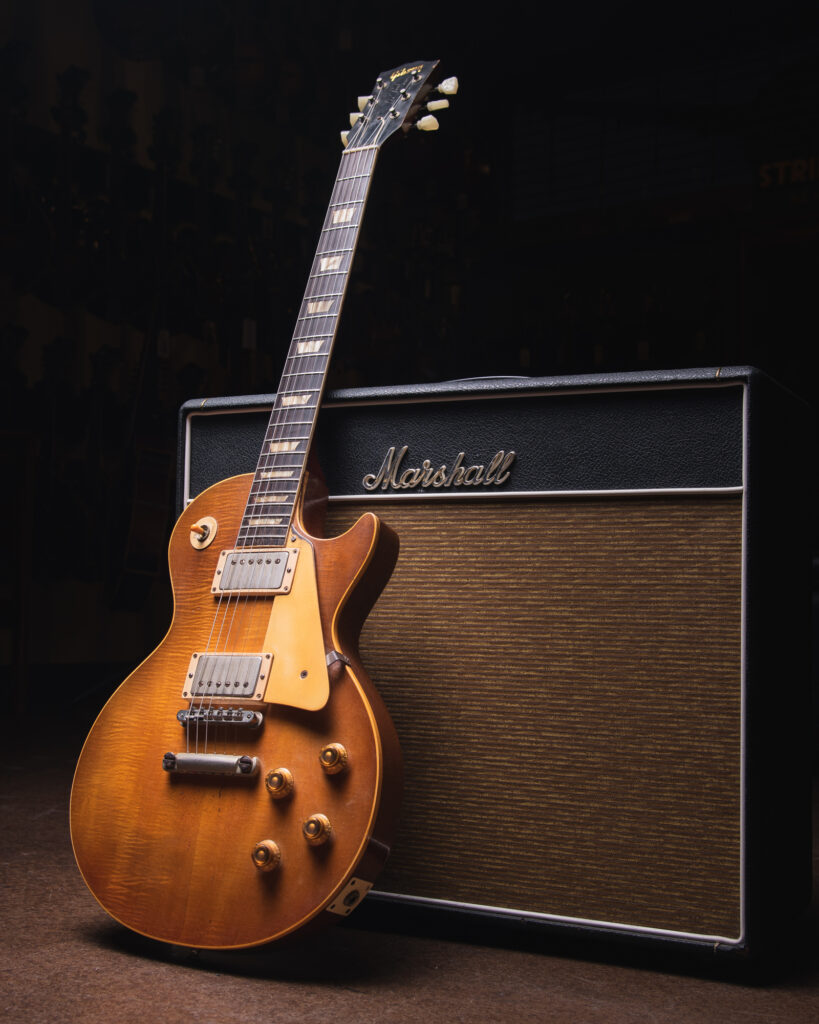
They went from a gold top to a sunburst finish on the top, and then they used a red aniline dye on the back of the guitar. So the back of the guitar has the distinctive red color. This didn’t really solve their sales problems, and unfortunately, these guitars didn’t sell very well. They were only made for about two years. The Sunbursts were introduced in mid ‘58, and by mid 1960, they were discontinued and replaced with a model called the Les Paul sg or solid guitar.
In 1965, Keith Richards came to America and he was playing a Les Paul Sunburst.
Keith’s more of a rhythm guitar player. So as far as the gunslinger thing goes with guitars, Keith wasn’t the guy. The guy that really started this whole thing with these guitars was Eric Clapton.
Clapton went to a section of London where a lot of music stores are, and one of Clapton’s main heroes was Freddie King. And he wanted a guitar like Freddy had. He wanted a gold top, and he went shopping. He couldn’t find one. What he found was an early 1960 burst. And at about the same time he joined John Mayall’s band. He had been in the Yardbirds, he joined John Mayall’s band in ‘65. In 1966, they put out a record John Mayall and the Blues Breakers with Eric Clapton. It’s called the Beano Record, because Clapton’s sitting on a curb with the rest of the band, and he’s reading a comic book called The Beano.
It was recorded like no other record was ever recorded before. Eric was insistent, he knew exactly the sound he wanted. He had a Marshall amplifier, a Combo, a 2-12 combo amplifier that became known as the Bluesbreaker. And he ran it wide open and the engineer was like, we can’t do that. And Clapton said, we have to do that. This is the only way I’m gonna do this. So the microphone was literally on one end of the studio, the amp was on the other end of the studio, and Eric made history with that recording. It was really the shot that was heard round the world as far as these guitars go.
All of a sudden, everybody wanted a Sunburst Les Paul standard. Billy Gibbons was with ZZ Top, Joe Walsh was with the James Gang, and James Patrick Page, “Jimmy Page” recorded the first Led Zeppelin record with a Telecaster in 1959, Telecaster.

The second Led Zeppelin record was with a Burst. That show Walsh sold him for $300. And if you talk to Paige about this, he still complains about the fact that he had to pay 300 bucks for a guitar. I guess he wanted it for free or something. That guitar famously had the neck shaved down a little bit. Jimmy liked really skinny necks. So did Joe, he loved really skinny, like 1960 burst necks.
Led Zeppelin two is a burst. If you listen to the first James Gang record, there’s a song called Bluebird, and you can hear Page’s Les Paul before it was Page’s. I always thought that was kind of cool. So after Clapton recorded the Beano record, came Peter Green playing a burst right after. And that record was called The Hard Road. The next record after that was a 20-year-old kid named Mick Taylor. And he was playing, you guessed it, a Les Paul Sunburst. And that record’s called Crusade. And all three of those records are seminal blues rock records. If you’re learning how to play rock and roll guitar or blues, you have to own those records.
It’s so important.
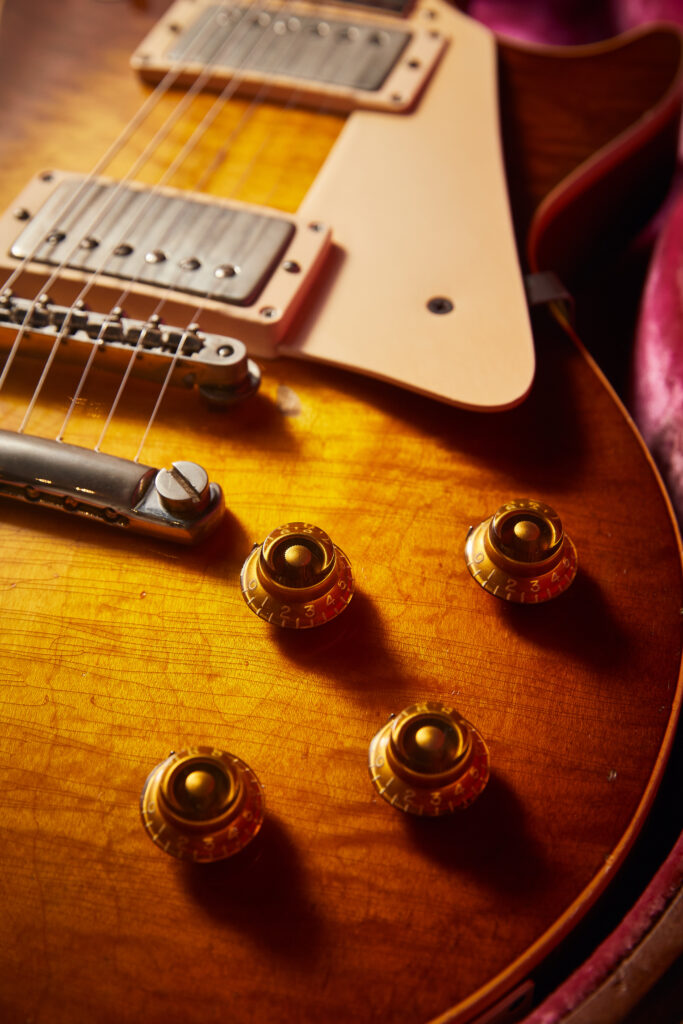
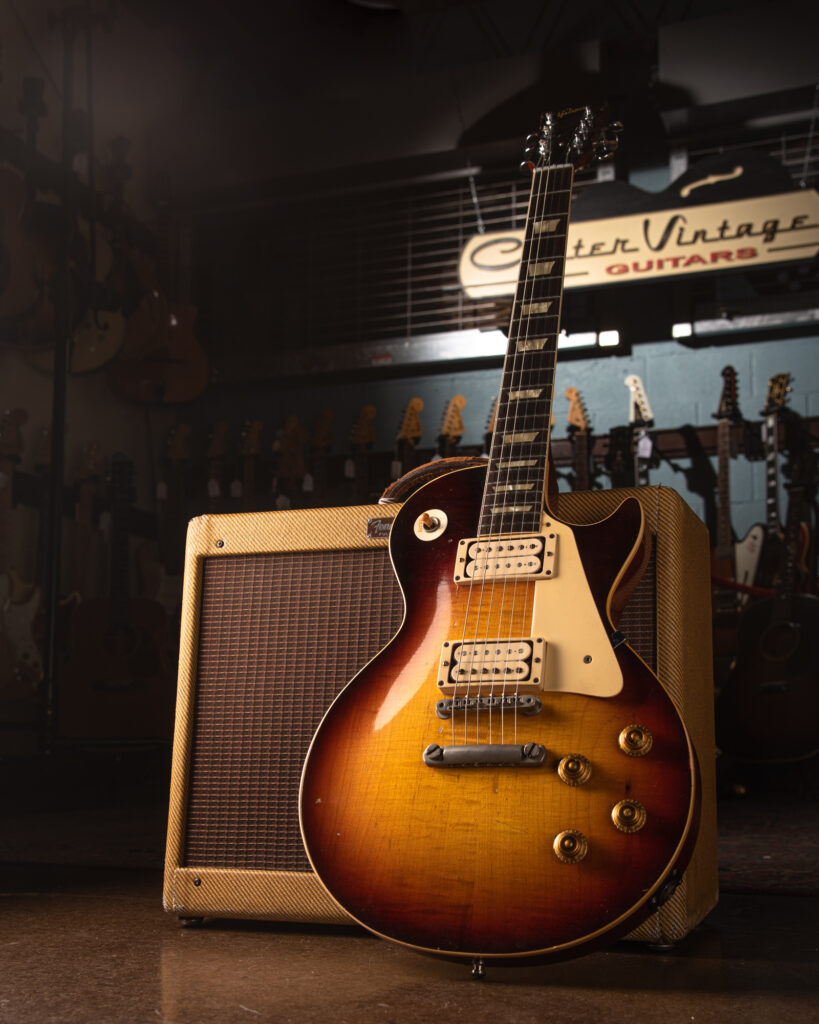
Not too long after that, we have a band called “Free” with Paul Rogers. And Paul Kossoff was the guitar player. Their big hit was, “All Right Now.” They had a lot of great hits. Kossof was one of the great Les Paul players, Billy Gibbons, Joe Perry with Aerosmith, of course, Duane Allman, and of course Bloomfield.
Mike Bloomfield was a huge influence on a lot of guitar players. And Mike traded his goldtop at a hundred dollars to Dan Erlewine in early 1967 for his guitar. And one of the funny things about that whole thing was Erlewine went on to later found Stuart McDonald, the guitar repair company. And when he traded his guitar to Mike, he had installed a new set of tuners on it, and they were backwards. So if you look real closely at the Monterey 1967, if you look at the electric flag video and you look at Bloomfield’s guitar, the tuners are backwards. It didn’t really hold Mike up at all. I think Mike was so high during that show, nothing would’ve held him back.
Iconic guitar. This is an excellent example. It’s probably really close to the time that Clapton’s guitar was produced, the Beano guitar. It’s got a ‘59 speck paint job. It’s got the older aniline dye paint job that fades. This is kind of like an iced tea burst. It has a thin neck as opposed to like ‘58s have big, thick necks. The ‘59s are a little bit more contoured and shaped by 60. The old guys used to call these speed necks. And they’re just super easy to play. One of the greatest designs ever, definitely favored by Clapton. Joe Walsh loves ’em and so does Jimmy Page.
So that’s a little look back at Les Pauls. Definitely one of the most collectible, if not the most collectible vintage guitar that’s ever come down the pike.
And the irony was that, you know, right out of the gate it was a failure. It took a few years for it to catch on.
So maybe that’s a good thing to remember. If at first you don’t succeed, just hang in there.
Gary Bohannon is Senior Authenticator and Acquisitions for Carter Vintage. If you have a vintage instrument you’d like to sell through CVG, reach out to info@cartervintage.com
